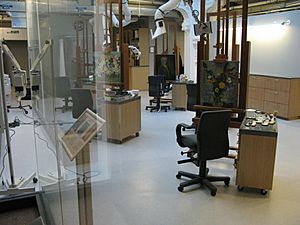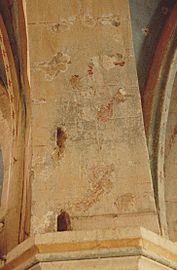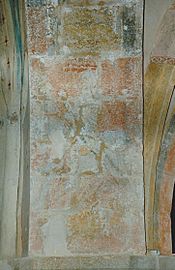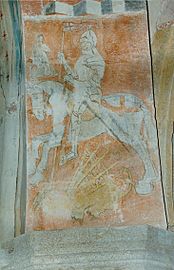Conservation (art) facts for kids
Conservation is all about protecting important things from the past so they can last for a long, long time. It's like being a superhero for history! People who work in conservation, called conservators, make sure that old artworks, historical objects, and buildings stay safe and sound for future generations to enjoy.
This special job involves several key steps:
- Looking closely: Examining an object to understand what it's made of and what problems it has.
- Writing it down: Documenting everything about the object and any work done on it.
- Fixing things: Treating the object to repair damage or stop it from getting worse.
- Keeping it safe: Protecting the object from things that could harm it, like light or humidity.
All this work is backed up by lots of research and learning!
Contents
What is a Conservator?
A conservator's main job is to take care of cultural heritage. This means old and important objects, artworks, or buildings that tell us about history and different cultures. They use special methods to keep these items in the best possible condition for as long as they can.
Think of a conservator as a guardian. They have important rules to follow, called ethical guidelines, to make sure they do their job right:
- Do the least possible: They try to do as little as possible to the object, only what's necessary to keep it safe.
- Use reversible methods: They use materials and techniques that can be undone later if needed, without harming the object.
- Keep detailed records: They write down everything they do to an object, including photos and notes, so everyone knows its history.
When deciding how to conserve something, a conservator also thinks about:
- What the owner of the object wants.
- How important the object is to history or culture.
- What the object is made of and what it needs to stay healthy.
How Do Conservators Work?
Conservators use a mix of science, art, and history in their work. They might use microscopes to look at tiny details, special chemicals to clean old paintings, or even 3D scanning to create digital copies of fragile items. Their goal is always to preserve the original object while making sure it's stable and safe.
For example, if an old painting has cracks, a conservator might carefully fill them in with special materials that match the original paint. If an ancient vase is broken, they might piece it back together using strong, reversible glues. It's all about slowing down time and protecting our shared past!
Gallery: Bringing a Mural Back to Life
This series of images shows how conservators worked to restore an old mural in France. It's a great example of how they carefully uncover and fix historical art.
Learn More
- Metropolitan Museum of Art, What is Art Conservation?
- Liverpool Museum, Agents of Deterioration





